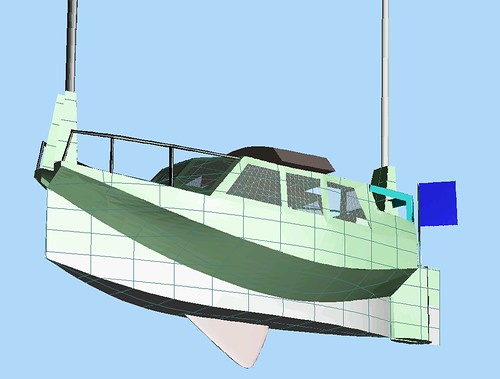 |
| Princess Tuvstarr gazing down into the dark waters of the forest tarn By John Bauer |
Swim out of your little pond.
-- Rumi
Bilgin' the Barge? Reflecting on the Pond
After the first day's sail aboard our first boat - a shoal, flattish bottomed life-boat conversion - we happily went about preparing a special meal for our first night at anchor.
To our consternation, some of our stores, stowed low and outboard, were mysteriously soaked! We checked the bilge under the floorboards and were relieved to see our customary few inches of water between lead ballast bricks (as low as we could pump it)... so we weren't sinking. Some fluke?
No further problems until the next time we went sailing. With the same, soggy result.
Turns out that, as we heeled, that little bit of water all ran to and piled up the low corner, climbing above the far end of our lowest shelves. Some water-tight storage boxes did the trick, but it left a bad taste.
*****
So this is a general problem for flat bottomed boats, especially those with no rocker amidships. Not only does all that flat skim of water add up when concentrated, but when upright there is no sump (a low point which concentrates water for efficient pumping).
But do we really need or want a (wet) bilge at all?
The purpose of the bilge is to collect and contain water that makes it inboard from outboard (seeping planks, say, or leaky through-hull fittings). Or oil spills from the engine.
But there are considerable downsides:
Basically, a sailor with a wet bilge is living above a pond of... well... bilgewater. A pond is always moisturizing its environs and contributes to that dank, musty smell that many think of as boaty. Mildew and 'dry' rot fungi love the humidity. Wooden boat frames tend to rot near the standing waterline of the bilge. Most bugs die of dehydration, but not if there's a pond handy.
Bilges themselves smell better, nowadays, than in the days when raw sewage was among the fluids, but a 'sweet smelling' bilge remains rare enough to be noteworthy.
In flat-bottomed boats, a bilge must be created by raising the sole (floor you walk on) by at least several inches. Another way of putting it is that you must lower any given headroom the same amount.
Traditional construction approaches are sufficient to achieve a dry bilge. As Larry Pardey put it, would you rather pump or sweep your bilge? It requires careful building and installations, with consistent, proactive maintenance. But doable.
With modern gap-filling adhesives and milled materials, we can achieve that high bar with much greater ease. With no more skill than is required to pull the trigger of a caulk gun and spread with a paddle, we too can achieve a truly watertight hull. And preserve precious headroom!
*****
In our boats, we go without a bilge. Generally, the inside of the hull is either the surface we walk upon, or against which we stow gear and goods.
This means, of course, that if salt-water gets in, you know it right away, and it's something to be dealt with pronto! As I've written, girder furnishings help contain any leak and localize any soaking.
In all these years, we've only had salt water intrusion twice. A new mooring ring sliced through two sets of line and chafe gear in a squall, and ZOON was blown onto a rock which ground a two foot hole through her side and bottom.
A wet bilge wouldn't have helped in this case.
SLACKTIDE drug two anchors while lying unattended in a squall and spent a happy few hours fracturing a couple spots in her bottom planking, which then seeped.
A wet bilge would have made life a bit easier, but then, we may never have fixed it by patching the inboard face? We're lazy that way.
*****
Once again, each of us finds the path that suits us. Some may prefer to pump, some to sweep. Some might hedge their bets with a dry bilge on standby. Others remember the adage, a leaky boat never sinks (yer always pumpin' her!).
Keeps it interesting!
P.S.... One nifty, fail-safer solution is to build a 'step' sharpie or barge - essentially a wide, hollow, keel that can serve as a bilge in an otherwise flat bottomed hull. It only need be deep enough to do the job.
The drawing below gives the general idea... I couldn't find a pic of one applied to a flat bottomed vessel.
 |
| Phil Bolger's BLONDIE HASLER |

One more advantage of the fixed furniture system is that any leak is initially contained by the furniture, as opposed to the entire bottom of the boat. as the top is open, if the leak gets too severe it will eventually spread. I believe this was the theory that made the Titanic unsinkable, good for small leaks
ReplyDeleteHi Dennis,
DeleteYes... both containment in case of a breach and buoyancy of unflooded 'chambers' help buy time.
Every bit helps!
But if at all possible, full positive buoyancy affords ultimate peace of mind!
Dave Z